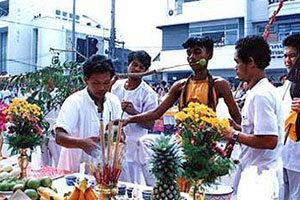The Tradition of Eating Vegetables

Rating: 3/5 (5 votes)
Phang Nga attractions
Attractions in Thailand
Opening days: Daily
Opening hours: 08.00 - 17.00
The Tradition of Eating Vegetables The time of the ceremony is 9 days, from the first day of the new moon to the 9th waxing moon of the ninth month of China (corresponding to the 11th month of Thailand).
Importance
Eating vegetables in Chinese is called "Kao Ung Je" or "Kew Wong Je". It is a tradition that has been practiced in the West by Thai people of Chinese descent. especially Phang Nga Province in Takuapa District Thai Mueang District Originally, people who ate vegetables were of Hokkien descent. but is now spreading to other groups.
The value of the ritual of eating vegetables In addition to helping to extract ward off disease or a disease from a person who eats vegetables.
It is also an expression of respect for the ancestors. and is to train the mind of the vegetable eater to be pure has kept the precepts and is also suitable for the current social conditions because it is the time to save on spending refrain from roaming Vegetable dishes are also cheaper. And finally, it also creates unity. Because those who join the vegetarian diet, whether rich or poor, will attend the ceremony in unison with smiling faces. greet me well As a result, the number of vegetable-eating participants, such as in Phang Nga Province, is increasing every year, indicating that the tradition of eating vegetables will continue for a long time.
Rituals The ritual of eating vegetables. One day before the ceremony, the shrine will be cleaned. frankincense and the flagpole was raised in front of the shrine for inviting your soul At midnight, there was a ceremony to summon King Emperor (Shiva) and Kiu Ong Tai Tei. or Kew Aung Hood Joo (9 elders) to preside over the ceremony Then hang nine oil lamps, which symbolize the spirit of Kiu Ong Taite, on the flagpole, indicating that the vegetable-eating ceremony has begun.
The use of 9 oil lamps is to refer to the spirit of Kiu Ong Tai Tei or Kao Oung Tai Tei, the word "Kao Oung Tai Tei" or Kiu Ong means Nopparacha according to Chinese astrology texts. means the planet It is believed that these 9 planets were formed by the division of 9 gods, which were very powerful. Manage the Earth Element, Water Element, Fire Element, Wind Element, and Gold Element. These 9 gods were born from the division of the former 7 Buddhas and 2 Bodhisattvas. because of all the elements that He gave as necessities in every body.
After the ceremony to accept you as president of the court, then there is a ceremony to lay the army guards in the direction called "Pang Ie" or Pang Kun" ceremony. This ceremony uses different colored flags. to be embroidered as a symbol of military deployment It is considered to be a song that is oriented in the direction. During the 9-day ceremonies, there will be several minor ceremonies.
1. Ceremony to worship you. On the first day of the ceremony, you will be worshiped with offerings. and in the homes of those who eat vegetables After eating vegetables for 3 days, he is considered pure. Also known as "Cheng", now there will be a ceremony to invite 2 Lords to join the ceremony. The first one is the owner who is responsible for surveying the birth name "Lum Tao" and the other is the owner who is responsible for surveying the deceased named " pak tao".
2. Kokun ceremony means raising soldiers. which is performed on the 3rd day, 6th evening and 9th evening. After noon, when the ceremony starts, food must be prepared and liquor for sacrifice Feed the soldiers and have grass or beans. to feed the horses Or when the ceremony is over at night, soldiers will be called in the direction of the direction called "Siamia".
3. Song Keng ceremony is a prayer that will begin to pray from when Phra Kew Ong Taite North Kew Ong Hudzhou came to sit in the amulet. and perform the chanting ceremony twice a day, in the morning and in the evening. It is the nature of the morning prayer. and evening prayer especially at night After the prayer, which uses the chants of Pak Tao Keng, there will be a "scramble", which is to read the list of people who participated in the vegetarian diet. which reads in front of the altar It's a form of admission.
1. Star worship ceremony will be performed on the night of the 7th day to ask for help protecting vegetable eaters.
2. The monks go on a trip or a parade It is an issue to please the animals to visit the respected people. There will be a parade of flags and name badges leading the parade. After that, there will be a swaying ceremony called "Kup Pea", where various idols of idols will be seated. Which will be arranged according to the class and the rank of the monks, for example, from Siyu upwards, it is Nguan Soi. The higher it is, it is a climber. high up as a hood Then it will be a large sedan parade. which usually uses 8 people and has a Chinese tier It will be the residence of Qiu Ong Hood Chou. As the procession passed Villagers will set an altar in front of the house. and light the firecrackers to welcome the procession when they arrive.
3. Wade through fire. A bonfire is considered a sacred fire. In sacred terms, it represents the power that keeps the fire from getting hot, or may be regarded as a divine fire. Used to purify the filth of the body by wading through both the Lord who is sitting. or the general public.
4. The ceremony of sending monks to do on the last day of fasting to eat vegetables. By midday, angels will be sent. Usually delivered in front of the flagpole. At night, Phra Kyu Ong Hood Chou will be sent back to heaven. by sending back by sea When the export procession leaves the door All the lights in the temple must be completely extinguished. The lanterns at the flagpole are pulled up at the highest in the morning of the first day. After finishing the vegetable-eating work, there will be a flagpole. and call back the troops After raising the soldiers Then opened the big door. When it is auspicious to open according to the calendar day or as you commanded.
The vegetable-eating tradition is believed to have started in China. The people of many cities in China held a vegetable-eating ceremony. This is to protect them from natural disasters and to purify their hearts and to remember the spirits of their ancestors that they respected and protected them. The Chinese in Phang Nga have held a vegetable-eating ritual until the present.
Vegetable eating traditions in Phang Nga Province especially at Takuapa District Started in the ritual of eating vegetables. The people attending the ceremony will wash the utensils that will be used for cooking until the fishy smell is gone. Some use a new set of utensils to cook or put vegetable dishes. Some went to eat in the kitchen. During this time of eating vegetables, those who are strict in the ceremony will dress in white clothes for 9 days.
The shrine's kitchen is heavily burdened with cooking for those who eat vegetables. Anyone wishing to receive food from the shrine must sign a request indicating the number of people in the household who participated in the vegetables and the number of days so that the kitchen can provide enough food. When it's time for food, the food can be brought to the house to eat. And because the number of people who eat vegetables is large, the kitchen has to find a lot of volunteers to help with the kitchen work. Food and kitchen expenses were donated by the faithful. and guests and from the vegetarian participants.
Food in the kitchen There are stir-fries, soups, and red curries, which are egg-free. and meat In addition, around the shrine are vendors selling various kinds of vegetables.
Important ceremonies during these nine days will be held by His Majesty by summoning various princes to sit in the body of the horse. is the one whose destiny is about to die will enter the body to renew or the right person and voluntarily become a royal horse You will also be seated.
During the various ceremonies or in the event of a procession to the royal horse to show the auspicious Slashing the weapon along his own body Some people pierced their tongues, cheeks, arms, and legs with spikes. The sharp knife did not show any wounds. The language the horse spoke while he was seated was always Chinese. Although the horse himself never knew anything about Chinese.
The performance of the horse is regarded as a pity for those who eat vegetables. by the monks being the victims themselves During the various ceremonies there will be drum fanfare. very noisy Many firecrackers were bought to be used during the ceremonial stage.
Comment
| Keyword (Advance) |
 Region
Region
|



 Category:
Category:  Group:
Group: